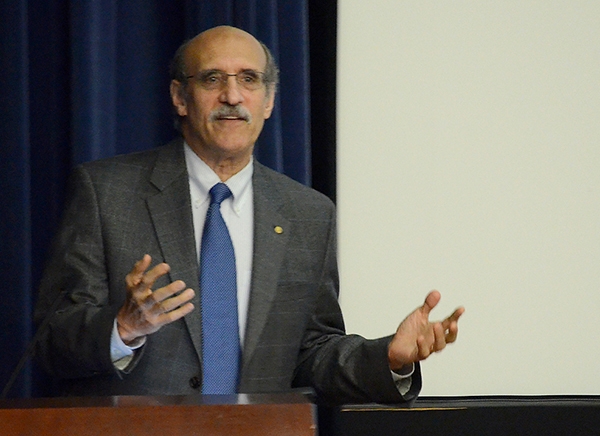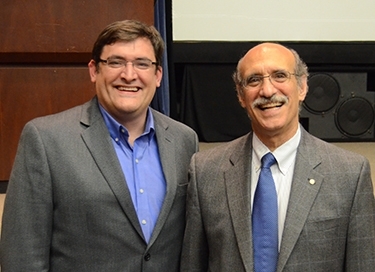Nobel Prize Winner Encourages Persistence in the Lab

MIDDLEBURY, Vt. – The co-recipient of the 2008 Nobel Prize in Chemistry told an audience of Middlebury College students, faculty, and community members that passion and excitement about science lead to great discoveries, and how scientists arrive at their discoveries is often quite surprising.
“Most discoveries in science are accidental,” said Professor Martin Chalfie of Columbia University. “Fundamental research is essential, scientific progress is cumulative, and postdoctoral fellows and graduate and undergraduate students are the true lab innovators,” he said, taking a moment to look out at the more than 200 undergraduates who filled Dana Auditorium on October 16 to hear his lecture.
Chalfie, together with Osamu Shimomura and Roger Y. Tsien, won the Nobel Prize for discovering green fluorescent protein (GFP), a biological marker that allows scientists to look at the inner workings of living cells in real time. GFP is a molecular beacon that has advanced the fields of medicine, biology, neurobiology, biochemistry, and others.
Since the publication of his seminal paper “Green Fluorescent Protein as a Marker for Gene Expression” in the journal Science in 1994, other researchers have cited GFP in over 100,000 papers, Chalfie said.
GFP has led to discoveries in fundamental science in gene expression, protein localization, mutational analysis, and brain circuitry. It has been applied to medical research pertaining to HIV/AIDS, infection, metastasis, and inherited diseases. And it has been used in some “unexpected ways,” Chalfie added, such as in art and industry.
To illustrate his point that some great discoveries are the result of an accident, he explained how Shimomura was working on the chemical origins of bioluminescent organisms when he casually discarded jellyfish (Aequorea victoria) tissue into a sink with other chemicals and it glowed green. This odd discovery appeared as a footnote in a paper – a paper that piqued the attention of Chalfie, who was working on methods of gene expression at the time.
Together with the students in his lab, Chalfie took Shimomura’s footnote, conducted his own experiments, and eventually disproved the long-held theory that a converting enzyme was necessary for GFP gene expression and fluorescence in a cell.
The affable professor, now 67 years of age, said smiling: “That’s probably the only footnote in history to win the Nobel Prize.” Chalfie’s persistence also buttressed another of his maxims about the nature of scientific discovery: stubbornness is a valuable asset in the lab.

p-375” title=”chalfie_erns-crop-375” width=”375” height=”272” />
Chalfie continues to explore uses for GFP in his own lab at Columbia University, where he studies touch sensation, nerve development, and the behavior of nerve cells both individually and in the aggregate in the model organism Caenohabditis elegans, a transparent roundworm.
One of his graduate students, Glen Ernstrom, is now an assistant professor of biology and neuroscience at Middlebury College. Ernstrom invited his mentor to campus to talk about GFP in the public lecture, and to give a more technical talk on the “Mechanosensory Transduction and its Modification in C. elegans” the following afternoon.
In both of his talks the Nobel-Prize winner emphasized the importance of basic science, and he paraphrased the physicist Enrico Fermi to drive home his point. “If you do an experiment and it confirms your hypothesis, then you have made a measurement,” said Chalfie. “But if you do an experiment and it doesn’t confirm your hypothesis, then you have made a discovery.”
– With reporting and photography by Robert Keren

